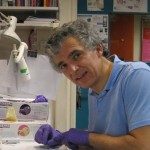Link to Pubmed [PMID] – 12068020
J. Biol. Chem. 2002 Aug;277(35):32015-9
The functional epitope of thrombin recognizing thrombomodulin was mapped using Ala-scanning mutagenesis of 54 residues located around the active site, the Na(+) binding loop, the 186-loop, the autolysis loop, exosite I, and exosite II. The epitope for thrombomodulin binding is shaped as a hot spot in exosite I, centered around the buried ion quartet formed by Arg(67), Lys(70), Glu(77), and Glu(80), and capped by the hydrophobic residues Tyr(76) and Ile(82). The hot spot is a much smaller subset of the structural epitope for thrombomodulin binding recently documented by x-ray crystallography. Interestingly, the contribution of each residue of the epitope to the binding free energy shows no correlation with the change in its accessible surface area upon formation of the thrombin-thrombomodulin complex. Furthermore, residues of the epitope are strongly coupled in the recognition of thrombomodulin, as seen for the interaction of human growth hormone and insulin with their receptors. Finally, the Ala substitution of two negatively charged residues in exosite II, Asp(100) and Asp(178), is found unexpectedly to significantly increase thrombomodulin binding.
